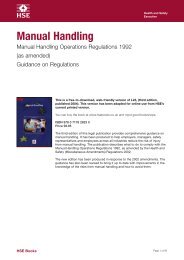Making Companies Safe - what works? (CCA ... - Unite the Union
Making Companies Safe - what works? (CCA ... - Unite the Union
Making Companies Safe - what works? (CCA ... - Unite the Union
You also want an ePaper? Increase the reach of your titles
YUMPU automatically turns print PDFs into web optimized ePapers that Google loves.
Support for <strong>the</strong>se findings comes from a number of methodologically rigorous studies of <strong>the</strong><br />
impact of regulation on OHS outcomes in <strong>the</strong> US. For instance, Lewis-Beck and Alford<br />
conducted an analysis of American coal mine legislation between 1940 and 1970, and found<br />
that a major factor in reducing <strong>the</strong> level of fatalities was <strong>the</strong> size of <strong>the</strong> Federal government’s<br />
budget allocation to health and safety regulation and <strong>the</strong> seriousness of enforcement<br />
measures taken. 18 Lewis-Beck and Alford’s findings were confirmed in a study by Perry, who<br />
concludes that:<br />
“The research indicates that strong safety laws reduce coal-mine fatalities and<br />
that, if laws are strong, coal-mine fatalities decrease with increases in Federal<br />
spending on mine health and safety.” 19<br />
And in one of <strong>the</strong> largest and most rigorous studies to have been undertaken on <strong>the</strong> impact<br />
of enforcement by <strong>the</strong> <strong>Unite</strong>d States Occupational <strong>Safe</strong>ty and Health Administration (OSHA)<br />
on workplace injuries, Gray and Scholz analysed data on injuries and OSHA inspections<br />
between 1979 and 1985 for a panel of 6,842 large manufacturing plants. 20 Having controlled<br />
for potential biases, <strong>the</strong>y found that inspections imposing penalties induced a 22% decline in<br />
injuries in inspected plants during <strong>the</strong> following few years.<br />
Similarly, in a more recent analysis, Baggs et al. investigated <strong>the</strong> impact of OSHA enforcement<br />
and consultation activities on workers’ compensation claims rates for all employers in<br />
Washington State. They found, after controlling for previous claims rate and average size, that<br />
claims rates for employers who had been subject to OSHA enforcement activity declined by<br />
22.5% for fixed-site employers and by 12.5% for non-fixed-site employers compared to<br />
reductions in claims rate of 7% and 7.4% respectively for those employers with no<br />
enforcement activity. The differences in reductions in claims rates – between employers<br />
subject to OSHA enforcement and employers that were not – were statistically significant.<br />
Interestingly, <strong>the</strong> researchers also found that OSHA consultation activities (that is, activity<br />
where <strong>the</strong>re was no threat or exercise of enforcement action) were not associated with a<br />
greater decline in compensable claims rates. 21<br />
These, and o<strong>the</strong>r studies, 22 indicate that consultation activity and brief inspections not<br />
resulting in penalties have no injury reducing effects. Moreover, <strong>the</strong>re are studies which show<br />
that inspections with no penalties may result in higher injury rates. 23<br />
Robust findings that OSHA enforcement has a strong and positive impact on worker’s health<br />
and safety are particularly interesting in view of <strong>the</strong> fact that a number of academic writers<br />
have criticized OSHA enforcement for being overly punitive and adversarial towards business.<br />
They argue that such an approach is both unnecessary and counter-productive since it risks<br />
losing <strong>the</strong> cooperation of industry and produces an instrumentalist response to compliance<br />
whereby companies will be motivated to address only <strong>the</strong> violations <strong>the</strong>y have been cited for<br />
but will not be motivated to move beyond this minimal compliance. 24<br />
OSHA’s style of enforcement is contrasted with <strong>the</strong> more ‘compliance-oriented approach’ of<br />
<strong>the</strong> UK regulatory authorities, where inspectors seek to secure compliance primarily through<br />
persuasion and co-operation ra<strong>the</strong>r than through strict enforcement and legal sanctions. 25<br />
Academics such as Bardach and Kagan in <strong>the</strong> US and Hawkins in <strong>the</strong> UK have argued that <strong>the</strong><br />
compliance approach to regulation, which typifies regulatory practice in <strong>the</strong> UK, is more effective<br />
than sanctioning or deterrence-based strategies, but this has been disputed by Pearce and<br />
Tombs who point out that <strong>the</strong>re is very little objective support for this proposition, and that<br />
<strong>what</strong> evidence <strong>the</strong>re is comes primarily from regulators and <strong>the</strong> business community itself.<br />
This is also <strong>the</strong> view of a recent OECD report, which concluded that <strong>the</strong>se ‘perception’<br />
studies were:<br />
“based on anecdotal ra<strong>the</strong>r than systematic evidence and [seem] to depend<br />
partially on defining being ‘in compliance’ as being substantially in compliance,<br />
and ignoring smaller ongoing violations.” 26<br />
One exception to this, discussed in <strong>the</strong> OECD report, is a systematic quantitative empirical<br />
study of nursing home regulation, which showed that when inspection teams used<br />
co-operative strategies of trust and ‘restorative justice’ non-compliance was reduced by 39% 43
















